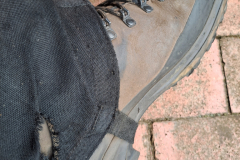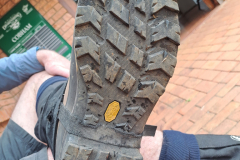Boots
A good pair of comfortable hiking boots is the first and most important item of equipment for any backpacker. Unlike shoes – even if they are designed for the bush – low-cut boots have a neck which provides ankle support when laced up correctly and prevents them from coming off your feet in deep snow. This is what the Ezemvelo KZN Wildlife Mountain Rescue Register is referring to in the column headed “Footwear for snow”.
A good pair of hiking boots should also be “waterproof” and nicely padded to help absorb shock when hiking over hard or rough terrain. This padding also reduces the chances of developing blisters, even when the boots are new. They will also be lined with a moisture-wicking material which may additionally provide extra warmth in winter.
The Natal Drakensberg can be especially harsh on hiking boots. Riverine bush, bracken and thatch grass are not kind to exposed stitching, so any so-called “hiking” boot that uses extra stitching as a fashion statement is going to be unpicked very quickly. The ideal hiking boot should have the absolute minimum of exposed stitching, which generally means it will be made of leather.
A rubber welt covering the full circumference of the joint between the sole and lower boot, and a kick pad over the toe of the boot, are also desirable features. A quality sole should last well and provide good grip in most conditions. Vibram soles are widely recognised as the world’s best.
The weight of your boots is another factor to consider. While runners favour the lightest footwear possible, this is not necessarily the case for hikers. The heavier the boot, the more rigid it is. This rigidity provides for better stability over rough terrain by reducing ankle rotation, so don’t expect to be able to run in heavy boots. Another benefit of heavy boots is that they offer greater penetration when moving through thick grass, bracken and snow. This is akin to breaking down a door with a heavy sledgehammer versus a light carpenter’s hammer. Lighter boots tend to glance off obstacles that heavier boots can move aside. As a result, you may feel a lot more surefooted in heavy boots than light ones, but you will be nimbler in light ones.
In summer in the Drakensberg, boots are exposed to a considerable amount of water from wet grass, flooded streams, rain and sweat. Most hiking boots have a shank to provide torsional rigidity, but if these are made of steel then you can expect them to corrode and eventually cause the insoles to break up, so rather select a boot with a Kevlar or plastic shank. Even so, it is preferable to remove your boots than wade through a river with them on – unless safety considerations dictate otherwise.
Ideally, hiking boots should also be waterproof. Various options are available, but the longest-lasting and best is probably Goretex. This waterproof membrane also helps to keep your feet dry by directing sweat out of the inner boot. However, do not be misled by what is meant by “waterproof”, because every boot has a very large hole that your foot fits through! This hole will let in any water that is above the height of the neck of the boot, or even lower if the tongue is not gusseted. Unless you are wearing waterproof gaiters over the necks of your boots, any wet grass will result in them becoming wet on the inside, regardless of the advertising. What waterproofing does do is prevent water from seeping into the boot from below the neck.
When sizing your boots, you should be able to insert a forefinger and middle finger between the back of your ankle and the inside of the boot without the laces done up. This is to allow for thicker hiking socks, and to ensure that when going downhill, your toes do not slide into the front of the boot. Your hiking boots should therefore be at least one size up on your normal, everyday work and leisure shoes.
Unfortunately, as expensive as a good pair of hiking boots is, they cannot be expected to last long even if you take the very best care of them. Don’t expect more than about 2 000 km of Drakensberg hiking in them. For an avid weekend hiker, this amounts to only about 2 to 4 years of hiking. Cheaper, fashion-type boots will last considerably less time and distance but you could use them for summer and keep your best boots for winter hiking.
There are numerous boot-care products on the market. Experience shows that water-based ones are not kind to leather. It is best to wipe excess dirt off leather boots, allow them to dry in the shade away from direct heat, then coat them with a wax-based leather-care product of the type you can get in any saddlery store. Synthetic boots should not be coated in this way – rather use one of the specialist products for them such as those sold by your boot retailer.
New leather boots generally take longer than synthetic ones to adapt to your feet. During this period you can expect some blisters, especially on your heels. If you experience blistering under your feet, consider replacing the insole with a specialist one made of thicker, more durable silicon or synthetic rubber. The better ones are quite costly but definitely worth it.
Socks
Choosing the correct socks to go with your boots is very important. Purpose-designed hiking socks are thick, padded, and shaped to fit your feet snugly. They often include moisture-wicking and thermal insulation as features. This is usually achieved by using a blend of natural and synthetic fibres that is also wear-resistant and shape-retaining. Many hikers wear two pairs of socks to achieve even more padding against shock, and to reduce the chances of getting hot-spots and blisters. It is possible to buy waterproof socks, which are ideal as the outer pair in really wet and cold conditions. Wet socks do not perform well, so you should remove them and squeeze the water out whenever you get the opportunity.
Gaiters
Gaiters come in two main forms: anklets and full-length. The latter are the best at reducing the amount of water that enters your boots through their necks. If they are of good quality and seal nicely around your boots, full-length gaiters effectively turn them into the equivalent of gum boots so far as keeping water out is concerned. This allows you to step in calf-deep water for a second or two when crossing rivers, without water getting inside your boots. Gaiters also keep out snow and debris such as grass, twigs and pebbles, and they help keep the inside of your boots fairly clean and mud-free. They may also provide some protection against snakebite and will certainly shield your expensive hiking socks from damage.Gaiters generally require at least two latching systems, one to close them around your calf, and a stirrup (loop) that goes under the boot to prevent them from creeping up your leg, especially in snow. Full-length gaiters often have an adjustable, locking garter at the top as well. A zip and / or Velcro is usually used for the closure, with the best option being a zip to close the gaiter and Velcro to close the storm flap that covers the zip. Beware of the manufacturer’s choice of zip though. The zip must be a coarse, quality one. Fine zip teeth easily clog with mud, they ice up more easily, and the forces applied to them can cause them to part or break more easily than a coarse-toothed zip. Quality-wise, YKK is probably the world’s best zip manufacturer. The zip / Velcro opening can be at the front or rear of the gaiter. Gaiters that close at the back of the leg make more sense for keeping out snow and water, but they are more difficult to put on and take off. Gaiters that close at the front offer a little more shin protection because of the extra padding offered by the closure system.
The stirrup is usually the clincher when choosing your gaiters. The most durable are made of stranded wire, followed by ones made of nylon webbing. Because the stirrup comes into contact with the ground, both options eventually wear through though. Leather, lace or plastic stirrups are a waste of money because they will probably wear through on your first weekend hike.
The latching and adjustment system for the stirrup is also important. A metal pin buckle is not infinitely adjustable, quickly gets bent, and eventually disintegrates. Some gaiters use Velcro, but the best option is a nylon webbing stirrup with a self-locking nylon buckle. Cam buckles should be avoided because they unlock themselves when they get caught in vegetation or narrow crevices. Loose, flapping stirrups can be dangerous – even fatal – should you stand on them with your other boot, so do not compromise on quality. When the stirrup eventually wears through, cut them off so you can continue using your gaiters safely. Stirrups are not essential for full-length gaiters because these tend to stay in place better than short gaiters.
There are some additional considerations when purchasing full-length gaiters. Many hikers complain about their discomfort, especially when worn over bare skin in summer. Some manufacturers have addressed this issue by adding zipped flaps on the outer sides of their gaiters that allow for some cooling. This adds to their cost and complexity though. Some manufacturers also offer breathable gaiters (e.g. lined with Goretex). This adds considerably to their price, and when worn over technical longs, this option would seem to be a waste. Gaiters made for colder climates may be lined with fleece to provide extra warmth, especially when hiking in deep snow. However, a simple pair of relatively cheap, long socks (e.g. soccer practice socks) can address some of these issues.
Using your gaiters
The closure mechanism for your gaiter stirrups should be on the outside of each foot. While they will brush against rocks and vegetation in this position, they will not be brushing against each other, which would cause them to wear faster and possibly even trip you up. Full-length gaiters especially are very definitely Left and Right.
If you usually use the same pair of gaiters with the same pair of boots, once you have adjusted the stirrups to the desired length, you should not have to make this adjustment again. From then on, when fitting your gaiters, all you need to do is hook the stirrups under your boots against the front of the heel steps, then close the gaiters around your legs.
In heavy rain, you should wear the legs of your rain pants over the gaiters themselves. This way, any water running down the pants will not seep into your boots via the tops of the gaiters. For deep snow, rather keep the legs of your trousers under the gaiters otherwise the snow will tend to bunch the bottoms of the trouser legs high up your calves.
Gaiters are subject to very high wear and tear and, rather like socks, should be considered consumables. The stirrups usually wear through first, and holes appear where they chafe against each other between your boots. The better quality gaiters usually have an extra layer of material in this area, which is another reason you need to put them on the correct leg. Manufacturers often print their logo on the outside of each gaiter to help you do this. The author has yet to see any gaiters with Right and Left clearly printed on them though!


